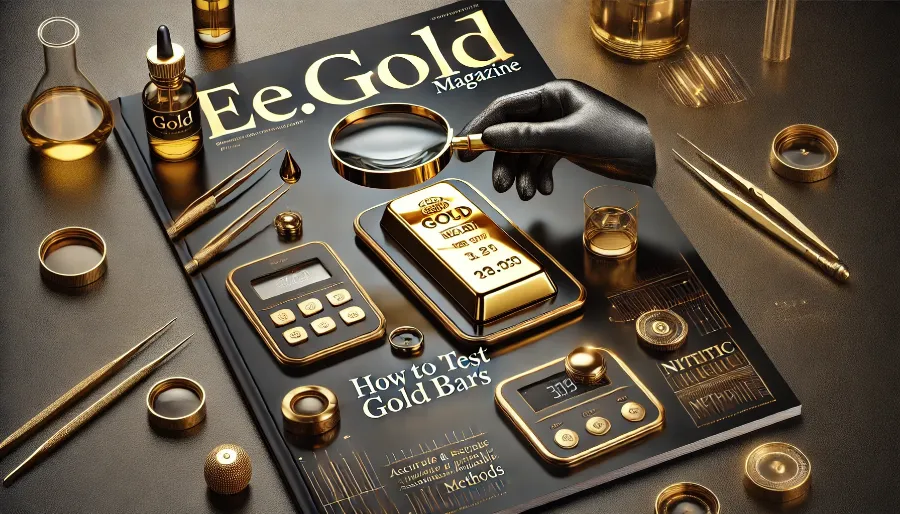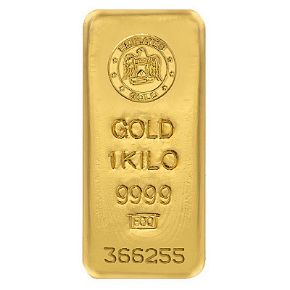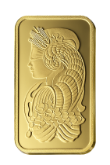
Why Testing Gold Bars is Crucial
Gold bars are a significant investment, and verifying their authenticity is vital to ensure their value and avoid counterfeits. Testing gold bars not only protects your financial interests but also builds confidence when buying, selling, or holding them. Authentic gold bars should meet specific weight, purity, and design standards, making testing an essential step for all investors.
What Tools Are Needed to Test Gold Bars
To test gold bars accurately, you will need basic tools that include a strong magnet for magnetic tests, a jeweler’s loupe for examining engravings and details, a digital scale for weight measurement, a ruler or caliper for dimensional checks, nitric acid for chemical testing, and a water container for density tests.
Who Should Test Gold Bars
Gold bar testing is beneficial for anyone involved in the gold market, including investors verifying their purchases, collectors ensuring the authenticity of their items, and sellers establishing trust with buyers. Whether you’re new to gold investments or a seasoned expert, testing is an invaluable skill.
Where to Begin Testing Gold Bars
Begin by visually inspecting the gold bar. Check for key details such as purity markings, weight, and the refiner’s logo, often engraved on the bar. For example, reputable brands like Valcambi, PAMP Suisse, or Credit Suisse include specific serial numbers and certifications. Use a magnifying glass to examine these engravings closely for signs of authenticity or tampering.
When to Test Gold Bars
Testing gold bars is essential in several situations, such as before purchasing from a private seller, after receiving bars as gifts or inheritances, or when preparing to sell them. Regular testing can also provide peace of mind if the bars are stored for long periods.
How to Test Gold Bars: Step-by-Step Methods
Magnet Test: Gold is not magnetic. Use a strong magnet to pass over the bar. If the bar sticks to the magnet or shows any attraction, it likely contains non-gold metals.
Weight Test: Use a digital scale to weigh the gold bar. Compare the weight with the specifications provided by the refiner. Authentic gold bars have precise weight standards, often listed on the bar itself or its certificate.
Dimension Test: Measure the bar’s length, width, and thickness with a ruler or caliper. Cross-check these dimensions with the manufacturer’s specifications to ensure accuracy.
Density Test: Place the gold bar in a container of water and measure the displaced water volume. Divide the weight of the bar by the water displacement to calculate its density. Authentic gold has a density of 19.3 g/cm³.
Acid Test: Apply a small drop of nitric acid to a discreet part of the bar. Real gold will not react, while fake gold may turn green or show bubbling. Handle nitric acid with care and use protective gloves.
Ultrasound Testing: Professional-grade ultrasonic machines can detect fake cores within gold bars by analyzing the internal structure. This method is more advanced and may require professional assistance.
Common Indicators of Fake Gold Bars
Recognizing counterfeit gold bars involves understanding their characteristics. Fake bars may have inconsistent markings, unusual weight or dimensions, magnetic properties, or discoloration around edges or engravings. These indicators should prompt further testing or professional verification.
The Importance of Serial Numbers in Gold Bars
Most reputable gold refiners include unique serial numbers on their bars. These numbers can be cross-referenced with the manufacturer or dealer for authenticity. Always verify that the serial number matches the certificate of authenticity provided.
How to Combine Home and Professional Gold Testing
While home tests are practical, high-value bars may require professional testing for added assurance. Certified jewelers and bullion dealers offer advanced testing methods, including X-ray fluorescence (XRF) analysis and spectrometry, which provide precise results without damaging the bar.
Why Gold Bar Testing Protects Your Investment
Testing gold bars is an essential part of maintaining their value and ensuring peace of mind. Authentic gold bars not only hold their worth but also command trust in the market. By testing your bars, you safeguard your investment against counterfeit risks and maintain their liquidity.
Storing Tested Gold Bars
Once you’ve verified the authenticity of your gold bars, proper storage ensures their longevity and security. Use tamper-proof cases, secure safes, or professional vault services to protect your investment. Consider labeling tested bars with details of the test results for future reference.
Testing Gold Bars as a Routine Practice
Regular testing of gold bars can prevent issues over time. Environmental factors like humidity or handling may not affect the gold’s core, but verifying its integrity periodically reinforces its value and authenticity.
Frequently Asked Questions About Testing Gold Bars
What is the most reliable method to test gold bars? The acid test and density test are among the most reliable home methods, but professional XRF testing offers the highest accuracy.
Can I test gold bars without damaging them? Yes, most methods like the magnet, weight, and density tests are non-invasive. However, acid tests may leave minor marks.
Are all gold bars marked with a serial number? Most reputable gold bars include serial numbers, but smaller bars or certain refineries may not.
How can I verify a gold bar’s serial number? Contact the refiner or dealer with the serial number to cross-check its authenticity.
Is fake gold common in the market? While rare in reputable markets, counterfeit gold exists, making testing essential.
What should I do if I suspect my gold bar is fake? Consult a professional jeweler or gold dealer for advanced testing and verification.
Can I perform a density test at home? Yes, with a digital scale and a water container, you can accurately calculate density.
What is the role of a certificate of authenticity? A certificate of authenticity verifies the weight, purity, and origin of the gold bar, adding credibility.
Do professional tests cost money? Yes, professional gold testing services typically charge a fee, but they provide precise results for high-value items.
How can I ensure my gold bars remain authentic over time? Store them securely, avoid excessive handling, and test them periodically to maintain their integrity.
Advanced Methods for Testing Gold Bars
For those who handle high-value gold bars or large quantities, advanced testing methods offer precision and reliability. These methods typically require professional-grade tools or expertise but provide a deeper level of analysis:
X-Ray Fluorescence (XRF) Testing: This non-invasive method uses X-rays to determine the composition of the gold bar. XRF testing is highly accurate and can identify the percentage of gold and other metals present in the bar. Many bullion dealers and jewelers offer this service.
Ultrasonic Testing: This method involves using ultrasonic waves to detect internal flaws or non-gold cores within the bar. It’s especially effective for verifying the integrity of larger gold bars that may have tungsten or other materials embedded within.
Fire Assay: Known as the most accurate method for determining gold purity, this process involves melting the gold and separating it from impurities. While highly precise, fire assays are destructive and typically used for refining or certification purposes.
Magnetic Resonance Testing: Advanced magnetic resonance devices can scan a gold bar’s interior for non-gold materials without causing damage. This method is effective for detecting counterfeit bars with cores of other metals.
How to Choose the Right Method for Testing Gold Bars
Your choice of testing method depends on the value, size, and purpose of the gold bar:
For Everyday Testing: The magnet, weight, and dimension tests are sufficient for initial verification.
For Medium-Value Bars: Combine home tests with professional services like acid or XRF testing.
For High-Value Bars: Invest in advanced methods like ultrasonic or magnetic resonance testing.
The Importance of Testing Before Buying Gold Bars
Performing due diligence before purchasing gold bars ensures you’re making a sound investment. Whether buying from a private seller, auction, or dealer, always request documentation, certificates, and previous test results. Combine this with your own testing to confirm the gold bar’s authenticity and value.
How Gold Bar Testing Builds Trust in the Market
The gold market thrives on trust, and testing gold bars plays a vital role in maintaining that trust. For buyers, testing ensures that the gold meets their expectations for purity and weight. For sellers, providing test results and certificates increases credibility and buyer confidence.
Example: A seller providing an XRF test report alongside a gold bar is likely to secure a higher price and more trust than one offering no verification.
Protecting Yourself from Counterfeit Gold Bars
Counterfeit gold bars are rare but can be highly sophisticated. To protect yourself:
Always buy from reputable dealers with a strong track record.
Verify serial numbers with the refiner’s database.
Use a combination of home tests and professional verification methods.
Be cautious of deals that seem too good to be true, as they often involve counterfeit products.
Digital Gold Verification Tools
Technology is making gold testing more accessible with digital tools and mobile apps. For example, apps like CertiEye allow you to scan the QR code on a gold bar’s certificate to verify its authenticity with the refiner’s database. Such tools add a layer of security and convenience for modern investors.
The Role of Gold Bar Testing in Estate Planning
For individuals passing down gold as part of their estate, ensuring authenticity is crucial. Tested and certified gold bars maintain their value and can be easily transferred to heirs. Providing documentation of authenticity simplifies the process and adds clarity for beneficiaries.
Why Testing is Essential for Gold Storage Services
If you use a professional storage service for your gold bars, periodic testing is essential to ensure their integrity. While most vaults maintain high security, regular testing provides peace of mind that your assets remain untampered.
Testing gold bars is a critical skill for protecting your investment and ensuring authenticity. By mastering these methods and combining them with professional resources when needed, you can confidently buy, hold, and sell gold bars while safeguarding their value for years to come.
NOTE
This Content is the copyrighted content of EE.GOLD. All rights are reserved. You are welcome to share or use our content only by including direct links to our website. Any other form of reproduction, distribution, or use without proper attribution is strictly prohibited.
This Content is intended solely for educational purposes. The information provided does not constitute financial or investment advice.
Please note that Digital Storage Receipt, Secure Storage Solutions, and Physical Gold Sales are the only services offered by EE.GOLD.
We strictly adhere to government regulations and are firmly against all illegal financial or investment activities globally.
For further inquiries, feel free to contact us through our official channels.










.png)

